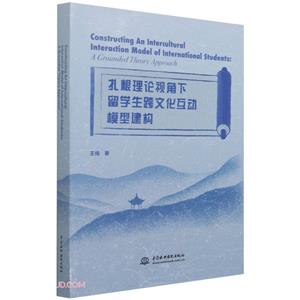中圖網小程序
一鍵登錄
更方便
本類五星書更多>
-
>
妙相梵容
-
>
基立爾蒙文:蒙文
-
>
我的石頭記
-
>
心靈元氣社
-
>
女性生存戰爭
-
>
縣中的孩子 中國縣域教育生態
-
>
(精)人類的明天(八品)
扎根理論視角下留學生跨文化互動模型建構 版權信息
- ISBN:9787517097068
- 條形碼:9787517097068 ; 978-7-5170-9706-8
- 裝幀:一般膠版紙
- 冊數:暫無
- 重量:暫無
- 所屬分類:>>
扎根理論視角下留學生跨文化互動模型建構 內容簡介
隨著中國經濟的快速發展和國際影響力的提高,中國政府為來華留學生提供多種不同的獎學金,來華留學生數量不斷上升,尤其以學位生為甚。有關在華留學生的現有研究大多從心理學角度或是影響跨文化適應的多種因素之間關系的探究,較少從認知的跨文化差異、跨文化適應中挑戰的多樣性以及應對措施的多元性等視角出發,對來華留學生跨文化適應的動態過程進行詳盡和深度的描述。本研究旨在發現在學術和社會情景下在華留學生適應方面面臨的問題和挑戰,并以扎根理論為基礎,構建跨文化互動模型,為來華留學生的跨文化適應提供理論指導。
扎根理論視角下留學生跨文化互動模型建構 目錄
ABSTRACT
ACKNOWLEDGMENTS
List of Figures
List of Tables
Chapter 1 Introduction
1.1 Background of Internationalization of Higher Education (IHE)
1.2 Background of IHE in China
1.3 Profiles of International Students in China
1.4 Research Questions
1.5 Organization of the Book
Chapter 2 Literature Review
2.1 Cultural-General Assimilator Frameworks
2.2 Intercultural Adiustment Models
2.2.1 Model of the Acculturation Process (Ward, 1996)
2.2.2 Model of Cross-Cultural Expertise Development (Bhawuk, 1998/2009)
2.3 Research on Coping Strategies
2.4 Research on the Study of International Students in China
2.5 Research on the Study of Intercultural Interactions in Shanghai
Chapter 3 Research Design and Methods
3.1 Grounded Theory Method (GTM)
3.1.1 An Overview of Grounded Theory Method (GTM)
3.1.2 Philosophical Assumptions of Grounded Theory Method
3.2 Research Design
3.3 Research Methods and Procedure
3.3.1 An Overview of the Procedure
3.3.2 Description of the Procedure
3.4 Reliability and Validity
Chapter 4 Three Rounds of Study: Procedures, Data and Findings
4.1 Overview
4.2 Round One: Exploring Stressful Interactions and Issues
4.2.1 Sampling
4.2.2 Data Collection Procedures
4.2.3 Data Analysis
4.2.4 Initial Findings
4.2.5 Discussion
4.2.6 Model Formation
4.3 Round Two: Examining Issues and Coping Strategies
4.3.1 Sampling
4.3.2 Data Collection Procedures
4.3.3 Data Analysis
4.3.4 Expanded Findings
4.3.5 Discussion
4.3.6 Model Extension
4.4 Round Three: Eliciting Cognitive and Affective Processes
4.4.1 Sampling
4.4.2 Data Collection Procedures
4.4.3 Data Analysis
4.4.4 Extended Findings
4.4.5 Discussion
4.4.6 Model EnrirhmPnt
Chapter 5 Integration and Model Development
5.1 Summary of Research Findings
5.1.1 Correspondence of Study Themes to the Themes from Cushner and Brislin
5.1.2 Discussion of Specific Issues Related to the Theroes
5.1.3 Correspondence of Study Themes to the Culture Specific Themes
5.1.4 Other Developed Themes Related to Coping Process
5.2 Development of an Intercultural Interaction Model
Chapter 6 Conclusion
6.1 Main Findings and Significance
6.1.1 Identifying Issues and its Related Factors
6.1.2 Confirming Coping Behaviors and Strategies
6.1.3 Developing Cases for Current and Future Analysis
6.1.4 Proposing an Intercultural Interaction Model
6.2 Theoretical Implications for Intercultural Adjustment and Education Research
6.3 Practical Implications for Educators, Practitioners, and International Students
6.4 Limitations of the Study
6.5 Future Research
References
Appendix One Codebook for Participants
Appendix Two Interview Protocol for Round One
Appendix Three Sample Interview Transc ripts Coding
Appendix Four The Remaining Five Cases from Round One
Appendix Five Interview Protocol for Round Two
Appendix Six The Remaining Five Cases from Round Two
Appendix Seven The Updated Fou r Cases from Round One
Appendix Eight Interview Protocol for Round Three
Appendix Nine Examples of Fi rst Cycle Coding
Appendix Ten Examples of Second Cycle Coding
Appendix Eleven The Other Th ree Cases from Round Three
ACKNOWLEDGMENTS
List of Figures
List of Tables
Chapter 1 Introduction
1.1 Background of Internationalization of Higher Education (IHE)
1.2 Background of IHE in China
1.3 Profiles of International Students in China
1.4 Research Questions
1.5 Organization of the Book
Chapter 2 Literature Review
2.1 Cultural-General Assimilator Frameworks
2.2 Intercultural Adiustment Models
2.2.1 Model of the Acculturation Process (Ward, 1996)
2.2.2 Model of Cross-Cultural Expertise Development (Bhawuk, 1998/2009)
2.3 Research on Coping Strategies
2.4 Research on the Study of International Students in China
2.5 Research on the Study of Intercultural Interactions in Shanghai
Chapter 3 Research Design and Methods
3.1 Grounded Theory Method (GTM)
3.1.1 An Overview of Grounded Theory Method (GTM)
3.1.2 Philosophical Assumptions of Grounded Theory Method
3.2 Research Design
3.3 Research Methods and Procedure
3.3.1 An Overview of the Procedure
3.3.2 Description of the Procedure
3.4 Reliability and Validity
Chapter 4 Three Rounds of Study: Procedures, Data and Findings
4.1 Overview
4.2 Round One: Exploring Stressful Interactions and Issues
4.2.1 Sampling
4.2.2 Data Collection Procedures
4.2.3 Data Analysis
4.2.4 Initial Findings
4.2.5 Discussion
4.2.6 Model Formation
4.3 Round Two: Examining Issues and Coping Strategies
4.3.1 Sampling
4.3.2 Data Collection Procedures
4.3.3 Data Analysis
4.3.4 Expanded Findings
4.3.5 Discussion
4.3.6 Model Extension
4.4 Round Three: Eliciting Cognitive and Affective Processes
4.4.1 Sampling
4.4.2 Data Collection Procedures
4.4.3 Data Analysis
4.4.4 Extended Findings
4.4.5 Discussion
4.4.6 Model EnrirhmPnt
Chapter 5 Integration and Model Development
5.1 Summary of Research Findings
5.1.1 Correspondence of Study Themes to the Themes from Cushner and Brislin
5.1.2 Discussion of Specific Issues Related to the Theroes
5.1.3 Correspondence of Study Themes to the Culture Specific Themes
5.1.4 Other Developed Themes Related to Coping Process
5.2 Development of an Intercultural Interaction Model
Chapter 6 Conclusion
6.1 Main Findings and Significance
6.1.1 Identifying Issues and its Related Factors
6.1.2 Confirming Coping Behaviors and Strategies
6.1.3 Developing Cases for Current and Future Analysis
6.1.4 Proposing an Intercultural Interaction Model
6.2 Theoretical Implications for Intercultural Adjustment and Education Research
6.3 Practical Implications for Educators, Practitioners, and International Students
6.4 Limitations of the Study
6.5 Future Research
References
Appendix One Codebook for Participants
Appendix Two Interview Protocol for Round One
Appendix Three Sample Interview Transc ripts Coding
Appendix Four The Remaining Five Cases from Round One
Appendix Five Interview Protocol for Round Two
Appendix Six The Remaining Five Cases from Round Two
Appendix Seven The Updated Fou r Cases from Round One
Appendix Eight Interview Protocol for Round Three
Appendix Nine Examples of Fi rst Cycle Coding
Appendix Ten Examples of Second Cycle Coding
Appendix Eleven The Other Th ree Cases from Round Three
展開全部
扎根理論視角下留學生跨文化互動模型建構 作者簡介
王絢,女,中共黨員,上海外國語大學博士,講師。主要研究方向為跨文化交際,在本領域發表文章10余篇,CSSCI期刊論文兩篇,參與省級及廳級項目10余部,參編論著3部。2005年澳大利亞悉尼大學碩士畢業后,開始在華北水利水電大學工作。2009年赴古巴哈瓦那大學學習西班牙語,2014年上海外國語大學訪問學者,2015年開始在上外攻讀博士,2017年赴美國夏威夷大學訪學。2019年取得博士學位。同年,應學校選派,赴北京水利部宣傳教育中心掛職鍛煉。
書友推薦
- >
龍榆生:詞曲概論/大家小書
- >
姑媽的寶刀
- >
朝聞道
- >
回憶愛瑪儂
- >
煙與鏡
- >
自卑與超越
- >
上帝之肋:男人的真實旅程
- >
經典常談
本類暢銷















